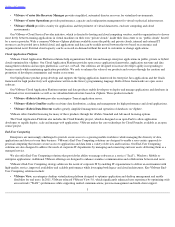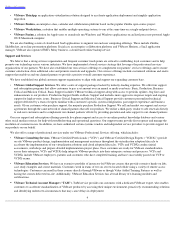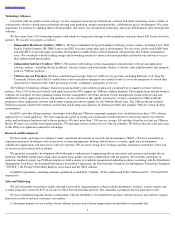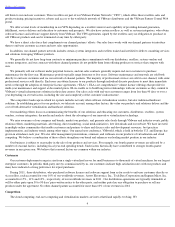VMware 2011 Annual Report Download - page 18
Download and view the complete annual report
Please find page 18 of the 2011 VMware annual report below. You can navigate through the pages in the report by either clicking on the pages listed below, or by using the keyword search tool below to find specific information within the annual report.
Table of Contents
In addition, although we plan to continue making strategic investments in our business, many of our competitors have significantly greater
financial, technical and other resources than we do, and if the economic recovery is anemic or not sustained, they may be better positioned to
continue investment in competitive technologies.
Industry alliances or consolidation may result in increased competition.
Some of our competitors have made acquisitions, entered into or extended partnerships or other strategic relationships to offer more
comprehensive virtualization and cloud computing solutions than they individually had offered. In 2011, Citrix Systems continued to invest in
desktop virtualization marketing by continuing its close collaboration with Microsoft and acquired smaller players like Kaviza and Ringcube.
Moreover, information technology companies are increasingly seeking to deliver top-to-bottom IT solutions to end users that combine
enterprise-level hardware and software solutions to provide an alternative to our virtualization platform. For example, in 2011, Oracle brought to
market integrated hardware and software solutions that utilized technologies from its 2010 acquisition of Sun Microsystems, and Microsoft and
Hewlett-Packard continued their collaboration based on Microsoft's cloud computing and virtualization platforms. Hewlett-Packard and Cisco
also joined the OpenStack effort, an effort to develop an open source solution for cloud computing. In 2011, Citrix announced its acquisition of
Cloud.com, which offers an IaaS cloud services solution, and Red Hat continued to invest in the Open Virtualization Alliance (OVA) to bolster
KVM as a direct competitor to VMware vSphere. On the PaaS front, Salesforce.com acquired Heroku in late 2010. We expect these trends to
continue as companies attempt to strengthen or maintain their market positions in the evolving virtualization infrastructure and enterprise IT
solutions industry. Many of the companies driving this trend have significantly greater financial, technical and other resources than we do and
may be better positioned to acquire and offer complementary products and technologies. The companies and alliances resulting from these
possible combinations may create more compelling product offerings and be able to offer greater pricing flexibility than we can or may engage
in business practices that make it more difficult for us to compete effectively, including on the basis of price, sales and marketing programs (such
as providing greater incentives to our channel partners to sell a competitor's product), technology or product functionality. This competition
could result in a substantial loss of customers or a reduction in our revenues.
Our operating results may fluctuate significantly, which makes our future results difficult to predict and may result in our operating results
falling below expectations or our guidance, which could cause the price of our Class A common stock to decline.
Our operating results may fluctuate due to a variety of factors, many of which are outside of our control. As a result, comparing our
operating results on a period-to-period basis may not be meaningful. Our past results should not be relied upon as an indication of our future
performance. In addition, a significant portion of our quarterly sales typically occurs during the last month of the quarter, which we believe
generally reflects customer buying patterns for enterprise technology. As a result, our quarterly operating results are difficult to predict even in
the near term. If our revenues or operating results fall below the expectations of investors or securities analysts or below any guidance we may
provide to the market, the price of our Class A common stock would likely decline substantially.
In addition, factors that may affect our operating results include, among others:
13
•
general economic conditions in our domestic and international markets and the effect that these conditions have on our customers' capital
budgets and the availability of funding for software purchases;
•
fluctuations in demand, adoption rates, sales cycles and pricing levels for our products and services;
•
fluctuations in foreign currency exchange rates;
•
changes in customers' budgets for information technology purchases and in the timing of their purchasing decisions;
• the timing of recognizing revenues in any given quarter, which, as a result of software revenue recognition policies, can be affected by a
number of factors, including product announcements, beta programs and product promotions that can cause revenue recognition of
certain orders to be deferred until future products to which customers are entitled become available;
•
the sale of our products in the time frames we anticipate, including the number and size of orders in each quarter;
• our ability to develop, introduce and ship in a timely manner new products and product enhancements that meet customer demand,
certification requirements and technical requirements;
•
the introduction of new pricing and packaging models for our product offerings;
•
the timing of the announcement or release of upgrades or new products by us or by our competitors;
• our ability to maintain scalable internal systems for reporting, order processing, license fulfillment, product delivery, purchasing, billing
and general accounting, among other functions;
























